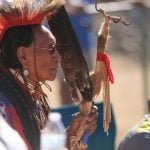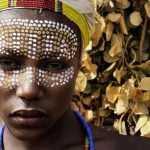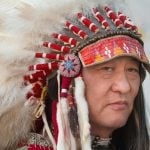Smoke Signals and Mirrors
A number of different Indian cultures used long-distance signaling systems in war and in hunting. The most stereotyped of these is the use of smoke-signals. Unlike the Plains Indian Sign Language which facilitated intertribal communication, there was no standard set of meanings for the puffs of smoke used in smoke signals. Each tribe established its own set of signals.

Shown above is a Frederick Remington painting of Indians sending smoke signals.
In making the smoke signals, different fuels were used to produce different kinds of smoke. Damp leaves and dung would be used to produce dark smoke, while wood and some dried grasses tend to produce a white smoke. To produce different puffs or streams of smoke, a wet blanket or hide would be placed over the fire and then removed.
Among the Karankawa of South Texas, more than 20 different kinds of smoke signals were used. These smoke signals included columns, spirals, zig-zags, and diverging lines.
Writing in 1873 about the Southeastern Indian tribes, archaeologist Charles Jones reported:
“In order to facilitate the rapid communication of intelligence, upon an emergency, the Southern Indians erected conical earth-mounds upon commanding points, such as the tops of hills, or elevated river-points. Fires kindled upon their summits could be readily recognized and interpreted.”
In this way, they would communicate rapidly over fairly long distances.
In addition to smoke signals, Indian people also used signal mirrors. The number and kinds of flashes were used to symbolize the communication. Mirror signals were commonly used by hunting scouts to indicate the type, number, and location of game. Similarly, war party scouts used mirrors to indicate information about the enemy. Among the Plains Cree, for example, many of the warriors carried a mirror, often in a beaded buckskin pouch, around their necks. The members of the group would agree in advance as to the meanings of the different flashes.
In addition to hunting and war, mirrors were also used to communicate between lovers.
In the Southwest, the Ancestral Puebloans (also called Anasazi), the ancestors of the modern Pueblos, constructed stone towers which facilitated signaling with smoke signals and mirrors. In the Chaco Canyon area of New Mexico, archaeologists have found several related mesa-top signal stations that provide for line-of-sight communications-presumably by smoke, fire, or reflected light. Fires were used for communicating at night, while during the day they would use smoke signals or mica mirrors. Chacoan society had an integrated system of instant communications. Archaeologists estimate that messages could be flashed throughout the Chaco Canyon area of New Mexico in just a matter of minutes, which enabled them to start ceremonies in several pueblos nearly simultaneously.
In other parts of the Ancestral Puebloan world, such as the pueblos in Colorado and Utah, stone towers served as a line-of-sight communication system to link the pueblos together. While these communication systems could have helped warn of possible enemy attacks, they also could be used to coordinate important ceremonies such as solstices and lunar maximums.
At the Mule Canyon Pueblo in Utah, the signal tower is linked to a kiva-an underground ceremonial chamber-with a tunnel which may have been used ceremonially. Stone towers in other pueblos in the area were used as a part of the visual communications system which used mirrors, crystal reflectors, fires, and smoke signals to tie the area together.
Another form of long distance communication involved the use of body signals. Different gestures and postures were used by scouts and lookouts to communicate with the main band.



